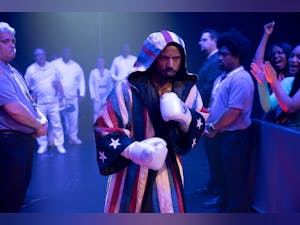From: Silver Screen
Native Cinema Showcase: Three standout short films that empower Indigenous storytelling

Hosted by the Smithsonian National Museum of the American Indian, the Native Cinema Showcase screened a multitude of short films and features from Nov. 12 to Nov. 18. For the second year in a row, the festival was held fully virtually because of the coronavirus pandemic, which allowed for a global audience to view these highlighted Indigenous stories.
This year, the showcase focused on how Native people assert their identity through language, community and their relationship with land and nature.
“Even as the presence of Indigenous writers and filmmakers grows in Hollywood, the program highlights the work many continue to produce in their own communities, on their own terms,” the museum’s acting director Machel Monenerkit said in the event’s press release.
The showcase impressively had a wide range of stories and voices encompassing Indigenous people across the world. Forty short films and seven feature films represented 39 Native
nations in 13 countries: United States, Canada, New Zealand, Australia, Mexico, Colombia, Chile, Guatemala, Peru, Brazil, Sweden, Greenland and the Solomon Islands. Here are three highlighted short films that celebrate the beautiful diversity of the Native diaspora.
“Between Two Lines” directed by Jack Steele
By Tristan Au
Filmmaker Jack Steele manages to condense a thoughtful, affecting war drama into a short film that looks and sounds immaculate in “Between Two Lines.” The film follows Burt (Clarence Ryan), an Indigenous Australian soldier fighting in World War I, as he gets caught in no man’s land with an opposing German soldier (Julian Felix) one foxhole over.
There’s an underlying, tragic depth to this film’s seemingly straightforward dialogue. Burt — unable to retreat to his trench — at first taunts the German soldier named Hans, only to learn that they have more in common than they had thought. Ryan’s performance combines subtle glances and silent stares to embody the hardship and trauma of Indigenous people to arresting effect.
The power of the narrative lies within the classic formula of empathizing with the enemy. “Between Two Lines” powers over war drama cliches with its exploration of identity: military men serving a country that doesn’t treat them like citizens compel us to reflect on America’s own past, which films like “Mudbound” have immortalized to arresting effect.
By the end of “Between Two Lines,” Steele leaves you wanting much more. It has the sound and set design of a big-budget production and an emotionally effective premise that can fuel a feature-length runtime. At the same time, the film ends poignantly — leaving us reflecting on not just the horrors of war but on how generational trauma affects Indigenous people everywhere.
“Sky Aelans” directed by Jeremy Gwao, Daniel Kakadi, Georgianna Lepping, Regina Lepping, Manner Levo, Junior Patrick Makau, Edward Manuga, Zahiyd Namo and Neil Nuia
By Olivia Kozlevcar
“Sky Aelans,” a short film about the communities living in the Solomon Islands’ last untouched rainforest, is a visual masterpiece that celebrates the power of culture and the beauty of nature.
The shots of the lush mountains and sweeping landscapes work wonderfully to capture the communities’ focus on nature and the life that surrounds them. Shades of green and gray color the film, highlighting the wet weather patterns of the region. The exposition is rounded out by brief vignettes of the lives of the insects and animals that inhabit the land.
Moments with the island’s inhabitants showcase dance, song and music that speak to their traditions and relationships with one another. It is a lovely glimpse into the lives of these communities that remain in such a special place — one that cannot be compared to anywhere else in the world.
Though brief, “Sky Aelans” is a touching film about the resilience of community.
“Tarcila: Indigenous Solutions to Climate Change from Peru" directed by Sarah Kuck
By Thais Carrion
In “Tarcila: Indigenous Solutions to Climate Change in Peru,” director Sarah Kuck introduces Tarcila Rivera Zea, a determined and accomplished Quechua activist who’s a member of the United Nations Permanent Forum on Indigenous Issues. Throughout the short documentary, we follow a moment in the life of Tarcila on her mission to empower other Quechua women and amplify their voices on how climate change directly affects their lives.
Emphasizing the importance of women in rural families and the feminine force of the natural world, Tarcila creates a space where women often neglected by both politicians and society can be heard. Backed by a small group of Quechua women, her initiatives set forth to change the rural education system, giving them resources to achieve success locally, instead of focusing on migrating to the cities.
Set in Tarcila’s homeland of Ayacucho and other Peruvian mountain towns, the shots throughout the film are nothing short of breathtaking. By the end, Tarcila’s character rivals the mountains themselves in all her steadfastness and determination to bring the initiatives she believes in to fruition. Rather than highlight the poverty of these communities, Kuck shows the audience the joy and love for the land that is at the core of Peruvian Indigenous culture, representing Tarcila and Indigenous communities with dignity and justice. Overall, the film is an inspiring look into one woman and her mission to empower others.
tau@theeagleonline.com and okozlevcar@theeagleonline.com




